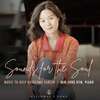
Each day during the lockdown in France, I decided to publish a short musical anecdote, an assortment of musical tales relating to recordings that hold either a personal resonance or is a particular favourite.
Some you may know, others perhaps not. Either way I hope you enjoy discovering or rediscovering these works.